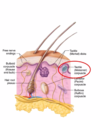W8 Nervous system Flashcards
(85 cards)
PICDescribe the general structure of a nerve
A bundle of axons (unmyelinated or myelinated) located outside the CNS, by a connective tissue layer called endoneurium. These groups of axons are connected to fascicles

State the 12 cranial nerves by both name and number
Olfactory Nerve (I) Optic Nerve (II) Occulomotor Nerve (III) Trochlear Nerve (IV) Trigeminal (V) Abducens Nerve (VI) Facial Nerve (VII) Vestibulocochlear (VIII) Glossopharyngeal Nerve (IX) Vagus Nerve (X) Accessory nerve (XI) Hypoglossal Nerve (XII)
What is the function of Olfactory Nerve (I) ?
Olfactory Nerve (I) Composed of entirely sensory axons, conducts nerve impulses for the sense of smell
What is the function of Optic Nerve (II)?
Composed of entirely sensory axons conducts nerve imuplses releated to vision
What is the function of Occulomotor Nerve (III)?
Is a mixed nerve. Sensory convey info related to proprioception Motor axon convey info for the movement of eyeball PSN alter lens and pupil size
What is the function of Trochlear nerve (IV)?
Mixed nerve
Sensory axons: convey info to the position in proprioception
Motor: convey info for the movement of eyeball
EDITWhat is the function of Trigeminal (V)
Mixed nerve: Largest of cranial nerves, mixed nerve Sensory axons: convey info related to touch, pain, temp, chewing Motor axons: Convey info related to chewing
What is the function of Abducens Nerve (VI)?
Mixed nerve: Sensory axon: converys info to the position of eye ball Motor axons: movement of eye ball
What is the function of Facial Nerve (VII)?
Mixed nerve
Sensory: info related to taste
Motor: movement of face
Autonmoic axons: control salivary glands
What is the function of Vestibulocochlear (VIII) Nerve?
Sensory nerve (two branches)
Vestibular branch: carries info for balance
Cochlear branch: carries in related to hearing
What is the function of Glossopharyngeal Nerve (IX)?
Mixed nerve
Sensory axon: swallowing, blood pressure
Motor axons: controls swallowing
Autonomic: controls saliva secretion
What is the function of Vagus Nerve (X)?
Mixed nerve, only nerve that extends beyond head
Sensory axons: convey info for taste, respiration, blood pressure, organs of abdominal cavities
Motor axons: controls muscles in speech and swallowing
Autonomic axons: heart, lungs, respiratory
What is the function of Accessory nerve (XI)?
Mixed nerve
Sensory axons: conveys info related to preconception of neck muscles
Motor axons: convey info related to swallowing and head movements
What is the function of Hypoglossal Nerve (XII)?
Mixed nerve
Sensory axons: convey info related to proprioception of tongue muscles
Motor axons: convey info related to control of tongue muscles related to speech and swallowng
What are spinal nerves?
Apart of the PNS, they connect the CNS to sensory receptors, muscles and glands in all parts of the body. There are 31 pairs
List the origins of the spinal nerves and name their branches
- There are 8 pairs of cervical nerves (C1-C8)
- There are 12 pairs of thoracic nerves (T1-T12)
- There are 5 pairs of lumbar nerbe (L1-L5)
- There are 5 pairs of sacral nerves (S1-S5)
- There is one pair on coccygeal nerves (Co1)
Describe a nerve plexus
A network formed by axons from adjacent nerves called a plexus, found on both LHS/RHS.

Name the 5 nerve plexuses and the regions they innervate
- The Cervical plexus 2. The brachial plexus 3. The lumbar plexus 4. The saccral plexus
What are groups of axons wrapped in endoneurium collected into?
Fascicles, nerves bunched together strengtehn the nerve fibers. Each fascicle is wrapped in a connective tissue called a perineurium. A final connective tissue layer called the epineirium forms the outer surface of the nerve
What are the two groups of nerves?
Cranial Nerves Spinal Nerves
What are cranial nerves?
Nerves that arise from the brain they pass through foramina in the cranial bones to innervate parts of the body
How are nerves compiled?
Most nerves are mixed, they contain axons from both motor and sensory neurons, sometimes autonomic
Name 3 Sensory nerves
- Olfactory nerve (I)
- Optic nerve (II)
- Vestibulocochlear nerve (VIII)
What are spinal nerves made up of?
Spinal nerve roots are where bundles of axons make up the spinal nerves that connect with the spinal cord. A spinal nerve is where the anterior and posterior roots come together










